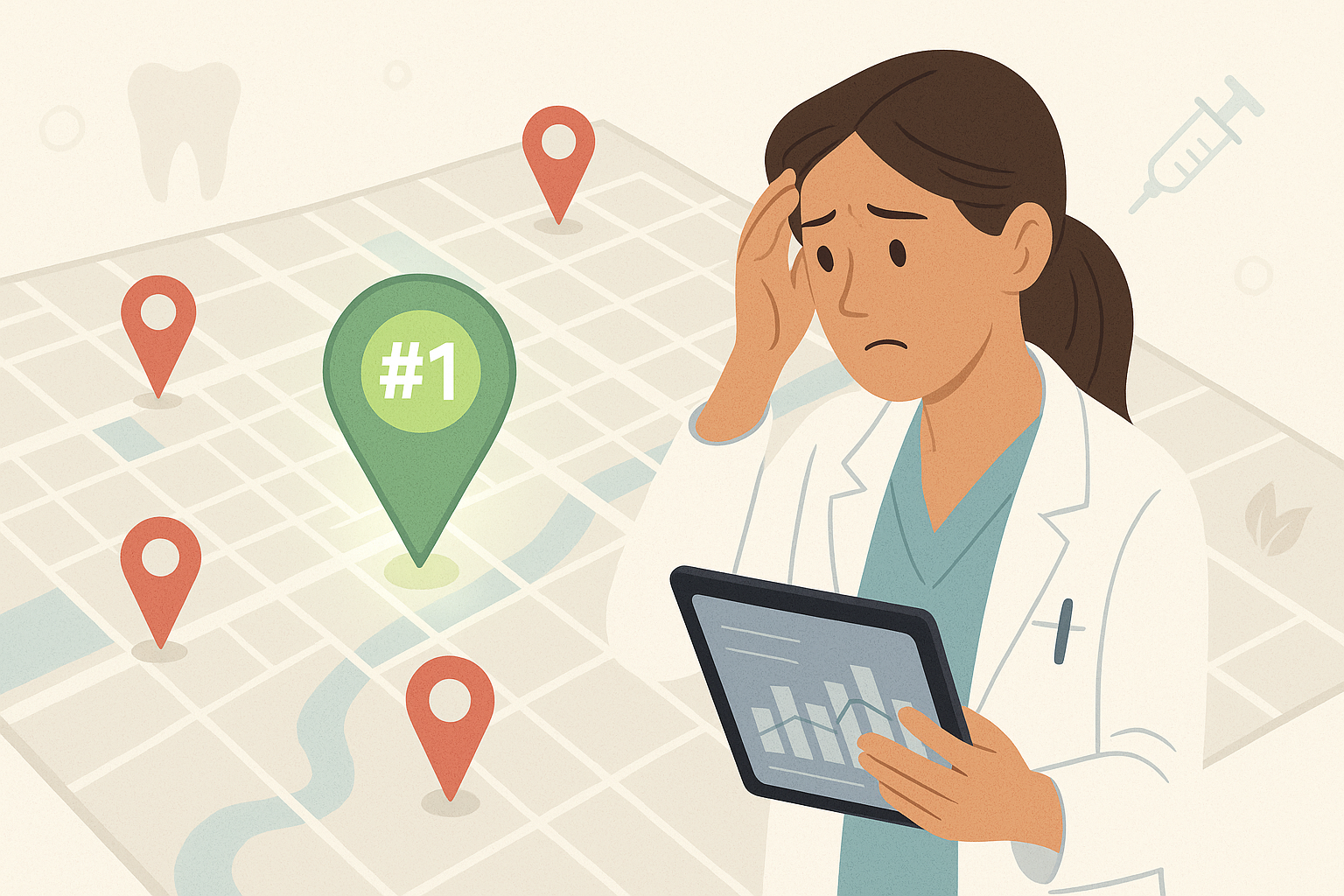Top 5 Map Rank Tracking & Reporting Mistakes (And How to Avoid Them)
🚨 You can’t fix what you don’t track—but what if you’re tracking the wrong things altogether?
For doctors, dentists, and clinic owners, Google Map rankings can make or break your patient pipeline. But here’s the catch: most practices either aren’t tracking correctly—or they’re trusting faulty reports that make them feel secure while their competitors quietly eat their lunch.
So, if you’ve been investing in local SEO and wondering, “Why aren’t we getting more patients?”, this post is your wake-up call.
🧭 Map Tracking is Your GPS—Don’t Drive Blindfolded
Think of your practice’s marketing like using GPS to navigate a road trip. You expect accuracy, real-time guidance, and confidence that you’re heading in the right direction.
But what happens if your GPS is outdated—or worse, shows you as already there when you’re miles away? That’s what happens when you rely on broken or incomplete rank tracking.
In this blog, we’ll walk through the five biggest mistakes clinics make when tracking Google Map rankings—and how to fix them for good. You’ll learn how to:
- Spot fake rankings that don’t reflect reality
- Focus on keywords that actually bring patients
- Track rankings by neighborhood or specialty
- Turn your data into ROI-driving actions
Let’s get your local rankings on the right track—literally.
1️⃣ Mistake #1: Relying on Manual Searches Instead of Geo-Grid Tracking
“Why You See Yourself Ranking #1—But New Patients Don’t”
If you’ve ever Googled your clinic and smiled because you’re ranking #1, don’t pop the champagne just yet.
Google tailors search results based on your IP address, device history, and even your personal behavior. That means you might see your practice ranking first—while a potential patient two miles away sees someone else entirely.
Why it matters:
Manual searches give you a false sense of success. You’re seeing a personalized version of Google, not what your actual prospects are seeing when they search “best medspa near me.”
What to do instead:
Use geo-grid tracking tools like Local Falcon, Places Scout, or Local Viking. These tools scan multiple points across a local area and show you how your ranking shifts from street to street.
📊 Stat: 93% of local searches trigger the Google Map Pack, but ranking positions can vary dramatically across even a 5-mile radius. (BrightLocal)
💬 Expert Insight:
“Without accurate local tracking, you’re flying blind. Data clarity creates patient flow.”
— Joy Hawkins, Local SEO Expert, Sterling Sky
2️⃣ Mistake #2: Ignoring the Top 3 Map Pack (and Settling for #4)
“If You’re Not in the Top 3, You’re Invisible”
Being ranked #4 on Google Maps sounds good… until you realize most people never even see it.
Google only shows the top 3 listings in the Map Pack before forcing users to click “More places.” That’s a huge drop-off point. If you’re in the fourth or fifth spot, your visibility plummets—and so does your phone activity.
Why it matters:
A small shift from #3 to #4 can mean a 70%+ drop in clicks. Many clinics don’t realize how critical this positioning is until appointment volume dips.
What to do instead:
Set your reporting to highlight only Map Pack positions 1-3, and treat anything below that as an opportunity to optimize, not celebrate.
📊 Stat: Listings in the top 3 spots get 75% of all Map clicks. Positions 4 and below get single-digit scraps. (Moz, Local SEO Ranking Factors)
💬 Expert Insight:
“Top 3 visibility is no longer optional—it’s the new front door to your clinic.”
— Darren Shaw, Founder, Whitespark
3️⃣ Mistake #3: Tracking Keywords That Don’t Convert
“Vanity Metrics Are Costing You Patients”
It’s easy to feel good when you rank for broad terms like “best doctor near me” or “top-rated medspa.” But here’s the thing: those keywords often bring in tire-kickers, not booked patients.
Why it matters:
High-volume keywords are often competitive, vague, and low-converting. They inflate your reports but don’t lead to real ROI. The better bet? Target high-intent, location + service keywords.
Think:
- “HydraFacial Richmond VA”
- “Invisalign dentist Toronto”
- “PRP treatment Beverly Hills”
What to do instead:
Cross-reference keyword rankings with actual lead data from your CRM or call tracking software. Focus your reporting on the 10–20 keywords that drive most of your booked appointments.
📊 Stat: 68% of top-converting local keywords include both a service and a location. (CallRail 2023 Benchmark Report)
💬 Expert Insight:
“Track what pays the bills, not what flatters the ego.”
— Neil Patel, Marketing Strategist & Author
4️⃣ Mistake #4: Not Segmenting by Location or Practice Type
“Your Downtown Rankings Aren’t Helping Your Suburb Clinic”
Running multiple locations or offering varied services? You need to track like it.
Too often, busy practice owners view a single report with combined data—missing the opportunity to spot what’s working (and what’s not) for each location or specialty.
Why it matters:
Local SEO is hyper-specific. A Botox ranking in the city center won’t help your hair restoration clinic in the suburbs. Each location has unique competitors, keywords, and search trends.
What to do instead:
Segment your reporting by location and service type. For example:
- Location A: “IV therapy clinic + zip code”
- Location B: “Weight loss injections + city”
Also, ensure each clinic has a separate Google Business Profile (GBP) with tailored content.
📊 Stat: Multi-location practices using geo-segmented reporting see 2.3x faster local growth. (Search Engine Journal)
💬 Expert Insight:
“Precision beats generalization—especially in local SEO.”
— Greg Gifford, VP of Search, SearchLab
5️⃣ Mistake #5: Reporting Without Context or Action
“All Data, No Decisions? That’s a Dead End”
Weekly reports full of numbers and charts look fancy—but if they don’t lead to any decisions or actions, what’s the point?
Why it matters:
Too many agencies send automated rank reports with no interpretation. You need clarity:
- What changed this month?
- What does that mean for patient volume?
- What are we doing next?
What to do instead:
Work with providers who deliver insight-based reporting: think narrative summaries, strategy recommendations, and task prioritization—not just raw data.
📊 Stat: Clinics that act on SEO data (rather than just reviewing it) grow 35% faster in traffic and visibility. (Ahrefs, 2023)
💬 Expert Insight:
“Numbers are just noise until you interpret and act on them.”
— Rand Fishkin, Co-Founder, Moz
✅ Wrap-Up: Better Tracking = Better Patients
Here’s the truth: strong Google Maps rankings don’t just happen. They’re the product of clear data, smart strategy, and consistent action.
To recap, avoid these five costly tracking mistakes:
- ❌ Manual searches that lie about rankings
- ❌ Settling for spot #4 in the Map Pack
- ❌ Tracking keywords that don’t convert
- ❌ Failing to segment by location or specialty
- ❌ Getting reports without clear next steps
When you track the right things, you attract the right patients.
So stop second-guessing your marketing and start making data-backed moves. Your competitors are investing in better visibility. It’s time you did too—with reports that lead to results, not just pretty PDFs.
Need help fixing your map rankings and getting more qualified patients?
Let’s talk. We offer turnkey marketing systems that show up in search, drive patient calls, and deliver real ROI—so you can focus on care, not clicks.


